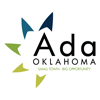Posted:4/30/2019 at 4:26:57 PM
City meets with US-EPA’s Deputy Assistant Administrator
for water, to discuss enhanced aquifer recharge
Ada - An Ada delegation met with the US-EPA’s new deputy assistant administrator (DAA) for water, Dennis Lee Forsgren Jr., to discuss the City’s on-going efforts to develop and deploy enhanced aquifer recharge. The collaborative research and development effort between the City of Ada, The Chickasaw Nation, East Central University, and Oklahoma State University has been attempting to use the new innovative approach to create additional water resources for Ada and other communities that utilize discharge from the Arbuckle-Simpson Aquifer (ASA) as their source of drinking water. The Subsurface Protection and Ecosystem Restoration Division (better known locally as Kerr Lab) of US-EPA has been providing technical assistance to the Chickasaw Nation and the City of Ada for the project. Dr. Guy Sewell, ECU Professor, and project leader for the EAR, met with Deputy Assistant Administrator Forsgren on April 5 at EPA headquarters. Dr. Sewell outlined the scope and objectives of the R&D efforts over the last 5 years. DAA Forsgren, noted the potential synergy with EPA’s research and programmatic objectives, was very supportive of the City of Ada’s progress, suggesting other US governmental agencies that could benefit from the expertise developed by the local research team. Discussions included the Oklahoma Congressional delegations support for area, and noted the bipartisan nature of federal efforts to support water resources.
“I was very impressed by the DAA’s willingness to meet and spend time with the City of Ada, and by his discussions of the implications and value of aquifer management.” said Dr. Sewell.
The City’s EAR project is the State of Oklahoma’s first in the Limited Scale Aquifer Storage and Recovery (LS-ASR) permit process, and is being closely watched by multiple state agencies, and ASA stakeholders. The ASA, which supplies water to nearly 150,000 people in south central Oklahoma, has been the rumored target of in-state and out of state water grabs, and is the States only designated soul source aquifer.
In the EAR process, runoff from large rainfall events is captured in a series of small retention structures to recharge the aquifer. “The EAR approach has several benefits,” says Sewell, “it can contribute to flood control, and provide additional spring and stream flow during dry periods.” The goal of the aquifer recharge process is to convert runoff in to base flow. Base Flow is the slow release of ground water into stream and river beds, and supplies most of the flow in Oklahoma rivers. EAR has been identified as a drought resiliency tool in the 2017, Arbuckle-Simpson Aquifer Drought Contingency Plan, produced by the Chickasaw Nation. The current project efforts are focused on ensuring that the recharge process is both safe and effective. “The next step will be to create an additional 1,100-acre feet of recharge in the Byrds Mill Spring capture zone, which has the potential to produce an extra million gallons per day from the spring and allow the City to avoid pumping ground water from the ASA” said City Manager Cody Holcomb.
A successful implementation of the EAR over the aquifer could provide benefits to many people who live over or utilize the aquifer for water or recreation. Maintaining stream flow is critical to ecosystem function in streams and riparian environments. It is also critical to municipalities that get their drinking water from the aquifer such as Ada, Tishomingo and Durant. Dr. Sewell also noted that the project team is also trying to define the linkage between grazing land productivity and an increase in the height of the water table in response to EAR application. “In a way we are trying to create the modern equivalent of beaver dams for the aquifer,” said Sewell, “which could strengthen the system’s resiliency to drought, and help to sustain the aquifer for current and future generations.”
For more information about the Enhanced Aquifer Recharge process and the City of Ada efforts, contact Dr. Guy W. Sewell at East Central University 580-559-5547.


